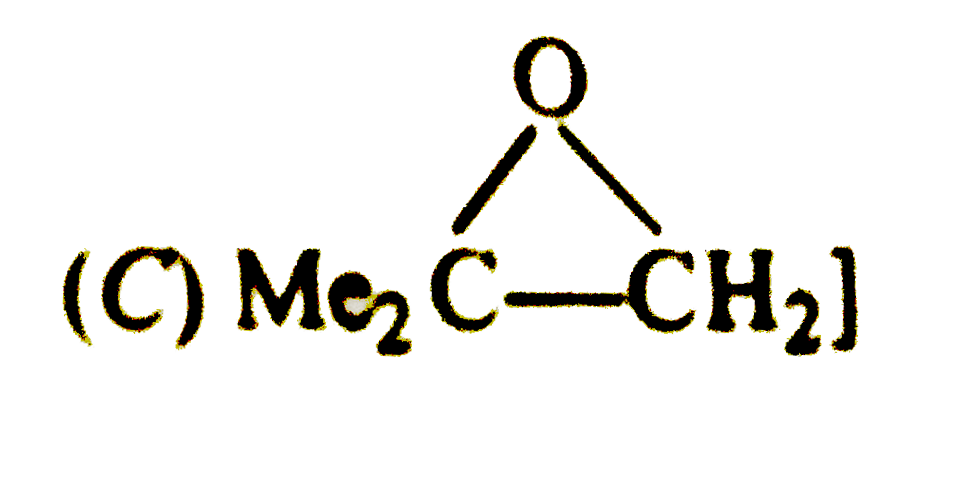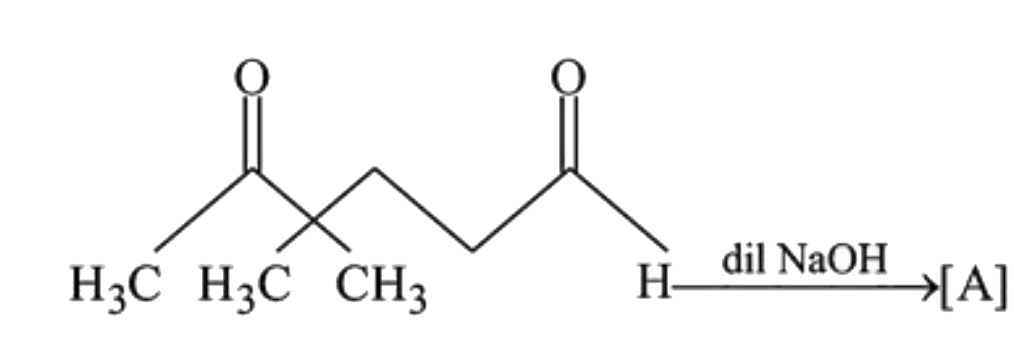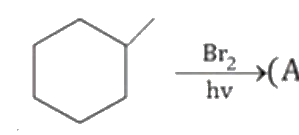C8H8Cl2(A)Aq. NaoH−−−−−→(B)Mild reduction−−−−−−−−→(C)l2/NaOH−−−−−→iodoform + acid salt(D)
PhCOCH3
PhCH(OH)CH3
PhCOONa
PhC(Cl)2CH3
The correct Answer is:D
To solve the problem step by step, we will analyze the reactions involved in transforming compound A (C8H8Cl2) into compound D (iodoform + acid salt).
Step 1: Identify Compound A
Compound A is given as C8H8Cl2. This can be represented as a structure that includes a phenyl group (C6H5) and two chlorine atoms attached to it, along with a methyl group (CH3). The structure can be drawn as follows:
C6H5CCl2CH3
Step 2: Reaction with Aqueous NaOH
When compound A is treated with aqueous NaOH, a nucleophilic substitution reaction occurs. The hydroxide ions (OH-) from NaOH will replace the chlorine atoms (Cl) in the compound.
The reaction can be represented as:
C6H5CCl2CH3+2NaOH→C6H5C(OH)2CH3+2NaCl+HCl
However, since two OH groups cannot remain in the same position, one water molecule is eliminated, leading to the formation of a carbonyl compound (ketone).
The resulting compound B is:
C6H5C(=O)CH3
Step 3: Mild Reduction of Compound B
Next, compound B undergoes mild reduction. In this step, the carbonyl group (C=O) is reduced to a hydroxyl group (C-OH).
The reaction can be represented as:
C6H5C(=O)CH3+H2→C6H5C(OH)CH3
The resulting compound C is:
C6H5C(OH)CH3
Step 4: Reaction of Compound C with I2 and NaOH
Finally, compound C is treated with iodine (I2) and sodium hydroxide (NaOH). This reaction leads to the formation of iodoform (CHI3) and an acid salt.
The reaction can be represented as:
C6H5C(OH)CH3+I2+NaOH→iodoform+acid salt
Conclusion
Now we can summarize the compounds:
- A: C8H8Cl2 = C6H5CCl2CH3
- B: C6H5C(=O)CH3
- C: C6H5C(OH)CH3
- D: Iodoform + Acid Salt
Final Answer
The compound B is:
B=C6H5C(=O)CH3
Compound A is given as C8H8Cl2. This can be represented as a structure that includes a phenyl group (C6H5) and two chlorine atoms attached to it, along with a methyl group (CH3). The structure can be drawn as follows:
When compound A is treated with aqueous NaOH, a nucleophilic substitution reaction occurs. The hydroxide ions (OH-) from NaOH will replace the chlorine atoms (Cl) in the compound.
C6H5CCl2CH3+2NaOH→C6H5C(OH)2CH3+2NaCl+HCl
C6H5C(=O)CH3
Next, compound B undergoes mild reduction. In this step, the carbonyl group (C=O) is reduced to a hydroxyl group (C-OH).
C6H5C(=O)CH3+H2→C6H5C(OH)CH3
C6H5C(OH)CH3
Finally, compound C is treated with iodine (I2) and sodium hydroxide (NaOH). This reaction leads to the formation of iodoform (CHI3) and an acid salt.
C6H5C(OH)CH3+I2+NaOH→iodoform+acid salt
Now we can summarize the compounds:
- A: C8H8Cl2 = C6H5CCl2CH3
- B: C6H5C(=O)CH3
- C: C6H5C(OH)CH3
- D: Iodoform + Acid Salt
The compound B is:
B=C6H5C(=O)CH3
Topper's Solved these Questions
- BOOK - NCERT FINGERTPS ENGLISHCHAPTER - HALOALKANES AND HALOARENESEXERCISE - Exemplar problems24videos
HALOALKANES AND HALOARENES
- BOOK - NCERT FINGERTPS ENGLISHCHAPTER - HALOALKANES AND HALOARENESEXERCISE - Assertion and reason15videos
HALOALKANES AND HALOARENES
- BOOK - NCERT FINGERTPS ENGLISHCHAPTER - HALOALKANES AND HALOARENESEXERCISE - Chemical reactions68videos
HALOALKANES AND HALOARENES
- BOOK - NCERT FINGERTPS ENGLISHCHAPTER - GENERAL PRINCIPLES AND PROCESSES OF ISOLATION OF ELEMENTSEXERCISE - Assertion And Reason15videos
GENERAL PRINCIPLES AND PROCESSES OF ISOLATION OF ELEMENTS
- BOOK - NCERT FINGERTPS ENGLISHCHAPTER - POLYMERS EXERCISE - NCERT Exemplar9videos
POLYMERS
Similar Questions
Knowledge Check
- Question 1 - Select One
Supply structural formulae for missing compounds.
(i) H2C=CH2+(A)→ClCH2−CH2OHH2SO4−−−−−−→413K(B)alc. KOH−−−−−−−→Δ(C)
(ii) CH3CHBrCH3alc. KOH−−−−→(A)HBr−−−−−→Peroxide(B)CH3ONa−−−−−→(C)
(iii) Me3CBralc. KOH−−−−→(A)HOCl−−−→(B)NaOH−−−→(C)
 AABCCH3CH=CH2CH3CH(Br)CH2BrCH3CH(OH)CH3BABCCH3CH=CH2CH3CH2CH2BrCH3CH2OCH2CH2CABCCH2CH=CH3CH3CH(Br)CH3CH3CH2OCH2CH2DABCCH2CH=CH3CH3CH2CH2BrCH2CH2CH2OCH3
AABCCH3CH=CH2CH3CH(Br)CH2BrCH3CH(OH)CH3BABCCH3CH=CH2CH3CH2CH2BrCH3CH2OCH2CH2CABCCH2CH=CH3CH3CH(Br)CH3CH3CH2OCH2CH2DABCCH2CH=CH3CH3CH2CH2BrCH2CH2CH2OCH3
ZnCI2+NaHCO3Heat−−→(A)Heat−−→(B)+(C)+H2O(B)+NaOH→(D)
Identify the compound (D) present in the solution.View SolutionSOCl2−−−→(A)KCN−−→(B)H+−−→(C ), the compound (C ) is
 View Solution
View Solution Hdil NaOH−−−−→[A]H2O+−−−→Δ[B]View Solution
Hdil NaOH−−−−→[A]H2O+−−−→Δ[B]View Solution Br2−−→hv(A)alc. KOH−−−−→(B)OsO4−−→(C)HlO4−−→(D), Identify 'D'View Solution
Br2−−→hv(A)alc. KOH−−−−→(B)OsO4−−→(C)HlO4−−→(D), Identify 'D'View SolutionC2H5OHPCl5−−→(A)KCN−−→(B)H3O+−−−→(C)NH3−−→(D)heat−−→(E)
Identify the productsView SolutionSiCl4H2O−−→(A)Heat−−→(B)Na2CO3−−−−→Heat(C),
The compound (C ) isView SolutionIn the following sequence of recation, identify the compounds (A), (B), (C ) and (D):
NSolutiona2CO3SO2−−→(A)Na2CO3−−−−→(B)S−−→Heat(C)AgNO3−−−→(D)View Solution

